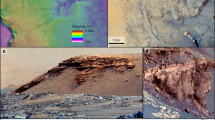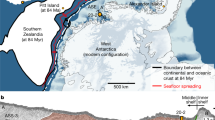Abstract
Ground ice in the crust and soil may be one of the largest reservoirs of water on Mars1,2,3. Near-surface ground ice is predicted to be stable at latitudes higher than 40° (ref. 4), where a number of geomorphologic features indicative of viscous creep and hence ground ice have been observed5. Mid-latitude soils have also been implicated as a water-ice reservoir6, the capacity of which is predicted to vary on a 100,000-year timescale owing to orbitally driven variations in climate7. It is uncertain, however, whether near-surface ground ice currently exists at these latitudes, and how it is changing with time. Here we report observational evidence for a mid-latitude reservoir of near-surface water ice occupying the pore space of soils. The thickness of the ice-occupied soil reservoir (1–10 m) and its distribution in the 30° to 60° latitude bands indicate a reservoir of (1.5–6.0) × 104 km3, equivalent to a global layer of water 10–40 cm thick. We infer that the reservoir was created during the last phase of high orbital obliquity less than 100,000 years ago, and is now being diminished.
This is a preview of subscription content, access via your institution
Access options
Subscribe to this journal
Receive 51 print issues and online access
$199.00 per year
only $3.90 per issue
Buy this article
- Purchase on Springer Link
- Instant access to full article PDF
Prices may be subject to local taxes which are calculated during checkout



Similar content being viewed by others
References
Squyres, S. W. Urey Prize Lecture: Water on Mars. Icarus 79, 229–288 (1989).
Carr, M. H. Water on Mars (Oxford Univ. Press, New York, 1996).
Clifford, S. M. A model for the hydrologic and climatic behavior of water on Mars. J. Geophys. Res. 98, 10973–11016 (1993).
Fanale, F. P., Salvail, J. R., Zent, A. P. & Postawko, S. E. Global distribution and migration of subsurface ice on Mars. Icarus 67, 1–18 (1986).
Squryes, S. W. & Carr, M. H. Geomorphic evidence for the distribution of ground ice on Mars. Science 231, 249–252 (1986).
Houben, W., Haberle, R. M., Young, R. E. & Zent, A. P. Modeling the martian seasonal water cycle. J. Geophys. Res. 102, 9069–9094 (1997).
Mellon, M. T. & Jakosky, B. M. The distribution and behavior of Martian ground ice during past and present epochs. J. Geophys. Res. 100, 11781–11799 (1995).
Malin, M. C. et al. Early view of Martian surface from the mars Orbiter Camera of Mars Global Surveyor. Science 279, 1681–1685 (1998).
Edgett, K. S. & Malin, M. C. New views of Mars eolian activity, materials, and surface properties: Three vignettes from the Mars Global Surveyor Mars Orbiter Camera. J. Geophys. Res. 105, 1623–1650 (2000).
Christensen, P. R. & Moore, H. J. in Mars (eds Kieffer, H. H., Jakosky, B. M., Snyder, C. W. & Matthews, M. S.) 686–729 (Univ. Arizona Press, Tuscon, 1992).
Cooper, C. D. & Mustard, J. F. Criteria for remote sensing detection of sulfate cemented soils on Mars. Lunar Planet. Sci. [online] 31, 1747 (2000).
Mustard, J. F. Recent ground ice on Mars and implications for volatiles and surface processes. Lunar Planet. Sci. [online] 32, 1988 (2001).
Seibert, N. M. & Kargel, J. S. Small-scale martian polygonal terrain: Implications for liquid surface water. Geophys. Res. Lett. 28, 899–902 (2001).
Johnson, J. J. & Lorenz, R. D. Thermophysical properties of Alaskan loess: An analog material for the martian polar layered terrain? Geophys. Res. Lett. 27, 2769–2772 (2000).
Storrs, A. D., Fanale, F. P., Saunders, R. S. & Stephens, J. B. The formation of filamentary sublimate residues (FSR) from mineral grains. Icarus 76, 493–512 (1988).
Haberle, R. M., Houben, W., Barnes, J. R. & Young, R. E. A simplified three-dimensional model for Martian climate studies. J. Geophys. Res. 102, 9051–9068 (1997).
Metzger, S. M. et al. Dust devil vortices seen by the Mars Pathfinder camera. Geophys. Res. Lett. 26, 2781–2784 (1999).
Renno, N. O. et al. Martian and terrestrial dust devils: Test of a scaling theory using Pathfinder data. J. Geophys. Res. 105, 1859–1865 (2000).
Herkenhoff, K. E. & Plaut, J. J. Surface ages and resurfacing rates of the polar layered deposits on Mars. Icarus 144, 243–253 (2000).
Kreslavsky, M. A. & Head, J. W. Kilometer scale roughness of Mars: Results from MOLA data analysis. J. Geophys. Res. 105, 26695–26712 (2000).
Acknowledgements
Discussions were provided by J. Head and P. Schultz and formal reviews were provided by M. Carr and B. Jakosky. The efforts of the MOC science team in creating the data base is gratefully acknowledged. This work is supported by grants from NASA.
Author information
Authors and Affiliations
Corresponding author
Rights and permissions
About this article
Cite this article
Mustard, J., Cooper, C. & Rifkin, M. Evidence for recent climate change on Mars from the identification of youthful near-surface ground ice. Nature 412, 411–414 (2001). https://doi.org/10.1038/35086515
Received:
Accepted:
Issue Date:
DOI: https://doi.org/10.1038/35086515
This article is cited by
-
Martian dunes indicative of wind regime shift in line with end of ice age
Nature (2023)
-
Martian moons exploration MMX: sample return mission to Phobos elucidating formation processes of habitable planets
Earth, Planets and Space (2022)
-
The importance of lake breach floods for valley incision on early Mars
Nature (2021)
-
Enabling Martian habitability with silica aerogel via the solid-state greenhouse effect
Nature Astronomy (2019)
-
Sublimation of terrestrial permafrost and the implications for ice-loss processes on Mars
Nature Communications (2019)
Comments
By submitting a comment you agree to abide by our Terms and Community Guidelines. If you find something abusive or that does not comply with our terms or guidelines please flag it as inappropriate.



